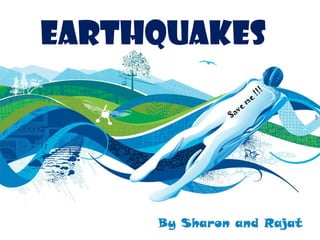
Sharon joji and rajat
- 1. earthquakes ! !! e m e Sav By Sharon and Rajat
- 2. What is an Earthquake? Earthquakes: Vibrations (seismic waves) Earthquakes within Earth materials are produced by the rapid release of energy Earth’s crust is in constant motion because of tectonic forces Earth’s crust can store elastic energy When forces exceed the elastic limits and structural strength of the rocks, the rocks will break and/or move producing vibrations that travel outward in all directions
- 3. Earthquakes o The actual place underground where the rocks break producing vibrations is called the focus o The place on the surface directly above the focus is called the epicenter
- 4. What types of forces are created? Compression Force: Force force pushing something together Makes a reverse fault
- 5. What types of forces are created? Tension Force: Force stretching or pulling force Makes a normal fault
- 6. What types of forces are created? Shear Force: Force a system of forces that operates against a body from different sides Makes a strike-slip fault
- 10. What causes Earthquakes? when the Movement along faults: occurs energy exceeds the friction holding the sides of the fault together and is suddenly released .Movement of magma (volcanic) Volcanic eruptions
- 11. Originate at the focus and travel outward in al Seismic Waves directions Foreshocks: small earthquakes that come Foreshocks before a major earthquake Aftershocks: Are adjustments in the crust Aftershocks after in earthquake o Smaller than main earthquake, but can cause as much or more damage. They can continue for weeks to months. Not every earthquake months produces aftershocks
- 12. 3 Types of seismic Waves P waves (primary waves) Compressional wave Particles move back and forth in the same direction as the wave Travels the fastest Can pass through solids and liquids (gases also) Does not cause damage
- 13. Types of Waves S wave (secondary wave, shear wave) Particles move at right angles to the direction of the wave Travels slower than P waves Can pass through solids only Does not cause damage
- 14. Types of Waves L wave (long wave, surface wave, ground wave) Particles move in elliptical orbit Originates on the surface after the P and S waves go straight up from the focus and reach the surface The L wave causes the damage and will be the strongest at the epicenter Travels the slowest
- 15. Earthquake Safety Protect yourself from falling objects (GET UNDER SOMETHING) or stand in a hallway or doorway (watch out for a swinging door) Do not try to go outside during the earthquake After the earthquake and before the aftershocks, go outside Do not return to the building until it has been inspected
- 16. Why japan is still alive after the massive earthquake
- 17. Sharon and Rajat
